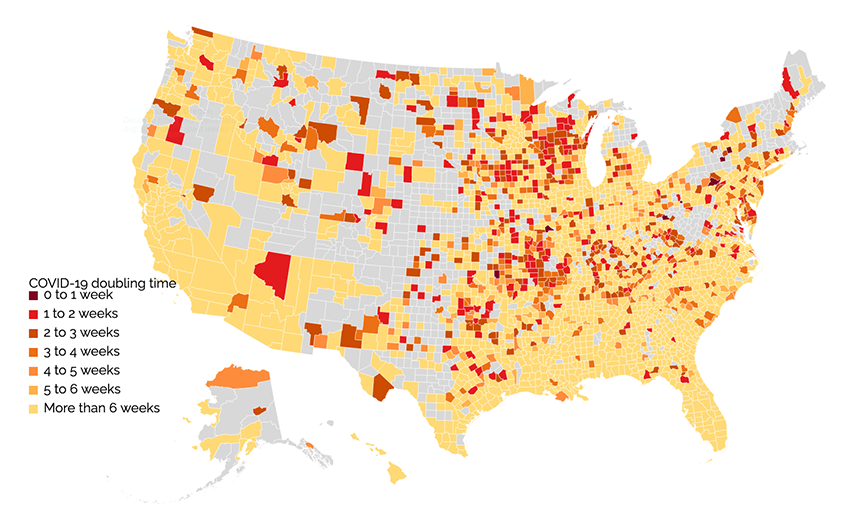
A snapshot of COVID-19 doubling time across the U.S. taken on Sept. 18, 2020, using an online tool developed by HMS researchers based at Mass General.
This article is part of Harvard Medical School’s continuing coverage of medicine, biomedical research, medical education and policy related to the SARS-CoV-2 pandemic and the disease COVID-19.
A new machine learning-based online tool developed by researchers at Harvard Medical School, Massachusetts General Hospital, Georgia Tech and Boston Medical Center allows for early detection of COVID-19 outbreaks in different U.S. counties.
The COVID-19 Outbreak Detection Tool, updated two to three times per week, predicts how fast an outbreak is spreading within a given county by estimating the doubling time of COVID-19 cases.
To make these predictions, the tool accounts for reported COVID-19 cases and deaths, face mask mandates, social distancing policies, changes in tests performed, rates of positive tests and the Centers for Disease Control and Prevention’s Social Vulnerability Index, which assesses the health-related resilience of individual communities when confronted with external stresses, such as natural or human-caused disasters or disease outbreaks.
The tool offers an interactive map and a “data explorer” that allows users to select a specific county to see that county’s population, total new cases and average daily cases of COVID-19 in the past week and the COVID-19 doubling rate, or how many days it takes for the number of cases to double in a given county.
“While earlier mitigation responses focused on state-level measures, such as a lockdown of an entire state, detecting local outbreaks will allow policymakers to implement measures at the county level, such as closing restaurants in a single county, to effectively contain the pandemic,” said Jagpreet Chhatwal, HMS assistant professor of radiology at Mass General and associate director of the Mass General Institute for Technology Assessment. “The model is able to detect many of the prior outbreaks within a matter of days.”
“For effectively controlling the pandemic, it is critical to detect an outbreak in a timely manner so that the affected area can be isolated and the spread of COVID-19 infections to neighboring areas can be minimized. However, due to several reasons, it may take days or even weeks for humans to manually detect an outbreak. Our data-driven machine learning-based solution significantly speeds up and automates that process,” said Turgay Ayer, director of business intelligence and healthcare analytics at the Center for Health and Humanitarian Systems and an associate professor at Georgia Tech.
Using the COVID-19 Outbreak Tool, the research team verified an outbreak in Johnson County in Iowa last week, which was linked to an outbreak at the University of Iowa. In addition, the tool identified several counties where outbreaks could be happening now. These include Rockingham County in Virginia, Wheeler County in Georgia, Monroe County in Indiana and Whitman County in Washington, where infections are doubling in less than one week.
Adapted from a Mass General news release.





